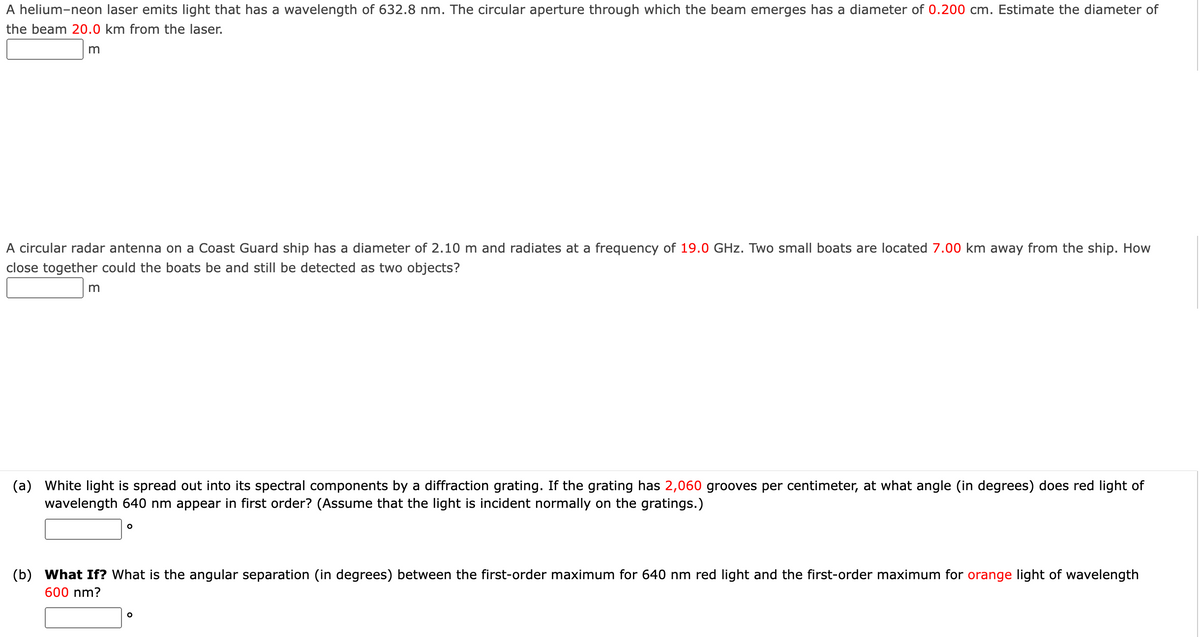A helium-neon laser emits light that has a wavelength of 632.8 nm. The circular aperture through which the beam emerges has a diameter of 0.200 cm. Estimate the diameter of the beam 20.0 km from the laser. m
A helium-neon laser emits light that has a wavelength of 632.8 nm. The circular aperture through which the beam emerges has a diameter of 0.200 cm. Estimate the diameter of the beam 20.0 km from the laser. m
University Physics Volume 3
17th Edition
ISBN:9781938168185
Author:William Moebs, Jeff Sanny
Publisher:William Moebs, Jeff Sanny
Chapter4: Diffraction
Section: Chapter Questions
Problem 102AP: Radio telescopes are telescopes used for the detection of radio emission from space. Because radio...
Related questions
Question

Transcribed Image Text:A helium-neon laser emits light that has a wavelength of 632.8 nm. The circular aperture through which the beam emerges has a diameter of 0.200 cm. Estimate the diameter of
the beam 20.0 km from the laser.
m
A circular radar antenna on a Coast Guard ship has a diameter of 2.10 m and radiates at a frequency of 19.0 GHz. Two small boats are located 7.00 km away from the ship. How
close together could the boats be and still be detected as two objects?
m
(a) White light is spread out into its spectral components by a diffraction grating. If the grating has 2,060 grooves per centimeter, at what angle (in degrees) does red light of
wavelength 640 nm appear in first order? (Assume that the light is incident normally on the gratings.)
O
(b) What If? What is the angular separation (in degrees) between the first-order maximum for 640 nm red light and the first-order maximum for orange light of wavelength
600 nm?
O
Expert Solution
This question has been solved!
Explore an expertly crafted, step-by-step solution for a thorough understanding of key concepts.
Step by step
Solved in 3 steps with 3 images

Knowledge Booster
Learn more about
Need a deep-dive on the concept behind this application? Look no further. Learn more about this topic, physics and related others by exploring similar questions and additional content below.Recommended textbooks for you

University Physics Volume 3
Physics
ISBN:
9781938168185
Author:
William Moebs, Jeff Sanny
Publisher:
OpenStax

Physics for Scientists and Engineers: Foundations…
Physics
ISBN:
9781133939146
Author:
Katz, Debora M.
Publisher:
Cengage Learning

Glencoe Physics: Principles and Problems, Student…
Physics
ISBN:
9780078807213
Author:
Paul W. Zitzewitz
Publisher:
Glencoe/McGraw-Hill

University Physics Volume 3
Physics
ISBN:
9781938168185
Author:
William Moebs, Jeff Sanny
Publisher:
OpenStax

Physics for Scientists and Engineers: Foundations…
Physics
ISBN:
9781133939146
Author:
Katz, Debora M.
Publisher:
Cengage Learning

Glencoe Physics: Principles and Problems, Student…
Physics
ISBN:
9780078807213
Author:
Paul W. Zitzewitz
Publisher:
Glencoe/McGraw-Hill

Principles of Physics: A Calculus-Based Text
Physics
ISBN:
9781133104261
Author:
Raymond A. Serway, John W. Jewett
Publisher:
Cengage Learning